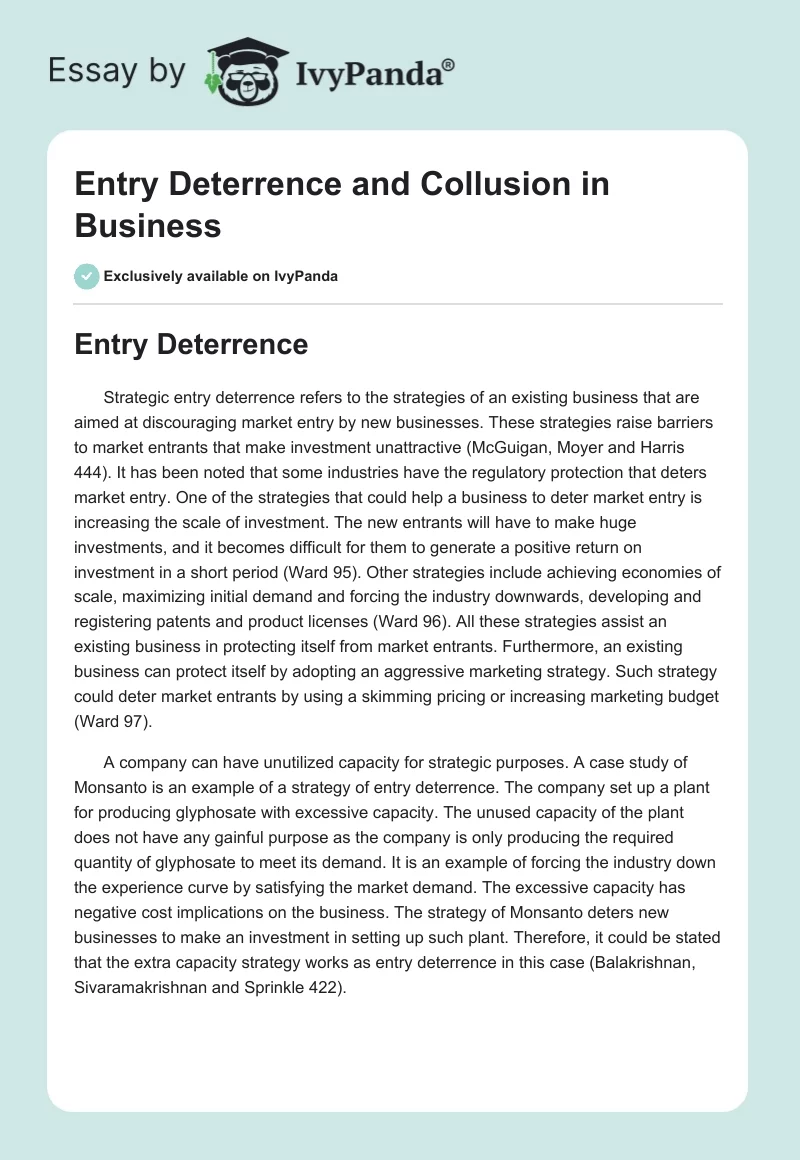Entry Deterrence
Strategic entry deterrence refers to the strategies of an existing business that are aimed at discouraging market entry by new businesses. These strategies raise barriers to market entrants that make investment unattractive (McGuigan, Moyer, and Harris 444). It has been noted that some industries have the regulatory protection that deters market entry. One of the strategies that could help a business to deter market entry is increasing the scale of investment.
The new entrants will have to make huge investments, and it becomes difficult for them to generate a positive return on investment in a short period (Ward 95). Other strategies include achieving economies of scale, maximizing initial demand and forcing the industry downwards, developing and registering patents and product licenses (Ward 96). All these strategies assist an existing business in protecting itself from market entrants. Furthermore, an existing business can protect itself by adopting an aggressive marketing strategy. Such a strategy could deter market entrants by using skimming pricing or increasing the marketing budget (Ward 97).
A company can have unutilized capacity for strategic purposes. A case study of Monsanto is an example of a strategy of entry deterrence. The company set up a plant for producing glyphosate with excessive capacity. The unused capacity of the plant does not have any gainful purpose as the company is only producing the required quantity of glyphosate to meet its demand. It is an example of forcing the industry down the experience curve by satisfying the market demand. The excessive capacity has negative cost implications on the business. The strategy of Monsanto deters new businesses to make an investment in setting up such a plant. Therefore, it could be stated that the extra capacity strategy works as entry deterrence in this case (Balakrishnan, Sivaramakrishnan, and Sprinkle 422).
Collusion
Collusion refers to an agreement between companies in the same market that allows them to alter the market’s equilibrium (Holt 111). Such strategies are often criticized for being unfair, unethical, and even illegal. The two types of collusive strategies are explicit collusion and tacit collusion (Hitt, Ireland and Hoskisson 277). Explicit collusion refers to the agreement between companies that directly compete to set prices for their products to their advantage. The companies can maximize their profits by collaborating with each other illegally. Other strategies could include controlling the output/supply of products.
Tacit collusion involves indirect coordination of companies to affect the price and output of their products by observing competitive actions and responses of each other (Chevalier-Roignant and Trigeorgis 145). Both strategies are aimed at distorting the market’s equilibrium and creating a situation that favors firms and generates high profits for them. Such practices are common in markets that have few players, and two or more firms dominate the market. It could also be highlighted that collisions are different from alliances that allow firms to coordinate and facilitate positive changes in the market.
A recent case study of collusion involved British Airways and Virgin Atlantic. The collusive collaboration between the two companies is considered illegal as they colluded to fix prices of furnace oil. The collusive strategy assisted both companies to take unfair advantage of pricing and generate higher profits. The authorities uncovered this arrangement between both companies. Virgin Atlantic accepted its involvement and British Airways was heavily fined (Hitt, Ireland and Hoskisson 298).
Works Cited
Balakrishnan, Ramji, Konduru Sivaramakrishnan, and Geoff Sprinkle. Managerial Accounting, New York, NY: John Wiley & Sons, 2008. Print.
Chevalier-Roignant, Benoît and Lenos Trigeorgis. Competitive Strategy: Options and Games, Massachusetts, MA: MIT Press, 2011. Print.
Hitt, Michael A., R. Duane Ireland, and Robert E. Hoskisson. Strategic Management: Concepts and Cases, Mason, Ohio: Cengage Learning, 2007. Print.
Holt, Charles A. Markets, Games, & Strategic Behavior, New Delhi, India: Pearson Education India, 2008. Print.
McGuigan, James R., R. Charles Moyer, and Frederick H. deB Harris. Managerial Economics: Applications, Strategy and Tactics, Mason, Ohio: Cengage Learning, 2010. Print.
Ward, Keith. Strategic Management Accounting, New York, NY: Routledge, 2012. Print.


